Abstract
The growth of breast cancer cells is under the regulation of hormones, growth factors, and their receptors. In the present study, we have employed a new, sensitive, and specific radioimmunoassay for the direct measurement of insulin receptors in surgical specimens of breast cancers. In 159 specimens the insulin receptor content was 6.15 +/- 3.69 ng/0.1 mg protein. This value was more than sixfold higher than the mean value found in both 27 normal breast tissues obtained at total mastectomy (0.95 + 0.68, P less than 0.001) and in six normal specimens obtained from reduction mammoplasty (0.84 +/- 0.78, P less than 0.001). The insulin receptor content in breast cancer tissues was also higher than in any normal tissue investigated including liver (Pezzino, V., V. Papa, V. Trischitta, A. Brunetti, P.A. Goodman, M.K. Treutelaar, J.A. Williams, B.A. Maddux, R. Vigneri, and I.D. Goldfine, 1989. Am. J. Physiol. 257:E451-457). The insulin receptor in breast cancer retained its ability to both bind insulin and undergo insulin-induced tyrosine kinase activation. Immunostaining of the specimens revealed that the insulin receptor was present in malignant epithelial cells, but was not detected in stromal and inflammatory cells. Univariant analysis revealed that the insulin receptor content of the tumors correlated positively with tumor size (P = 0.014), histological grading (P = 0.030), and the estrogen receptor content (P = 0.035). There were no significant correlations between insulin receptor content and the age, body weight, menopausal status, and nodal involvement of the patients. These studies indicate, therefore, that the insulin receptor content is increased in breast cancers and raise the possibility that the insulin receptor may have a role in the biology of these tumors.
Full text
PDF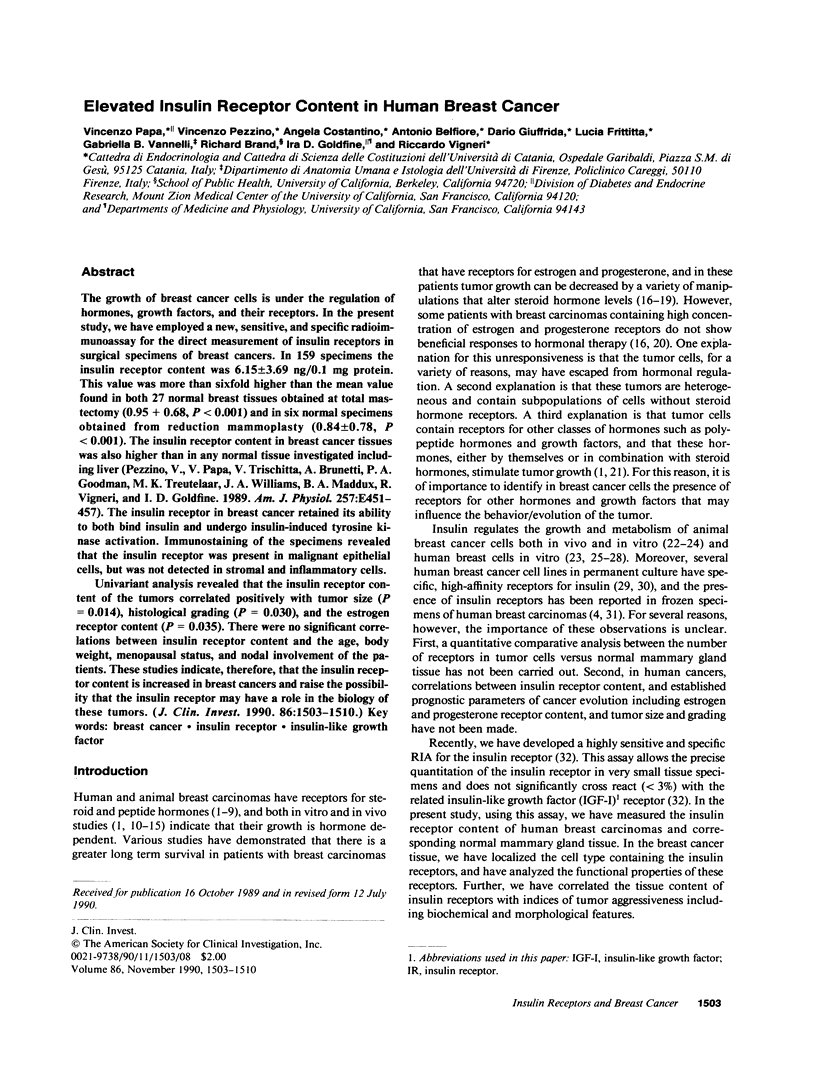
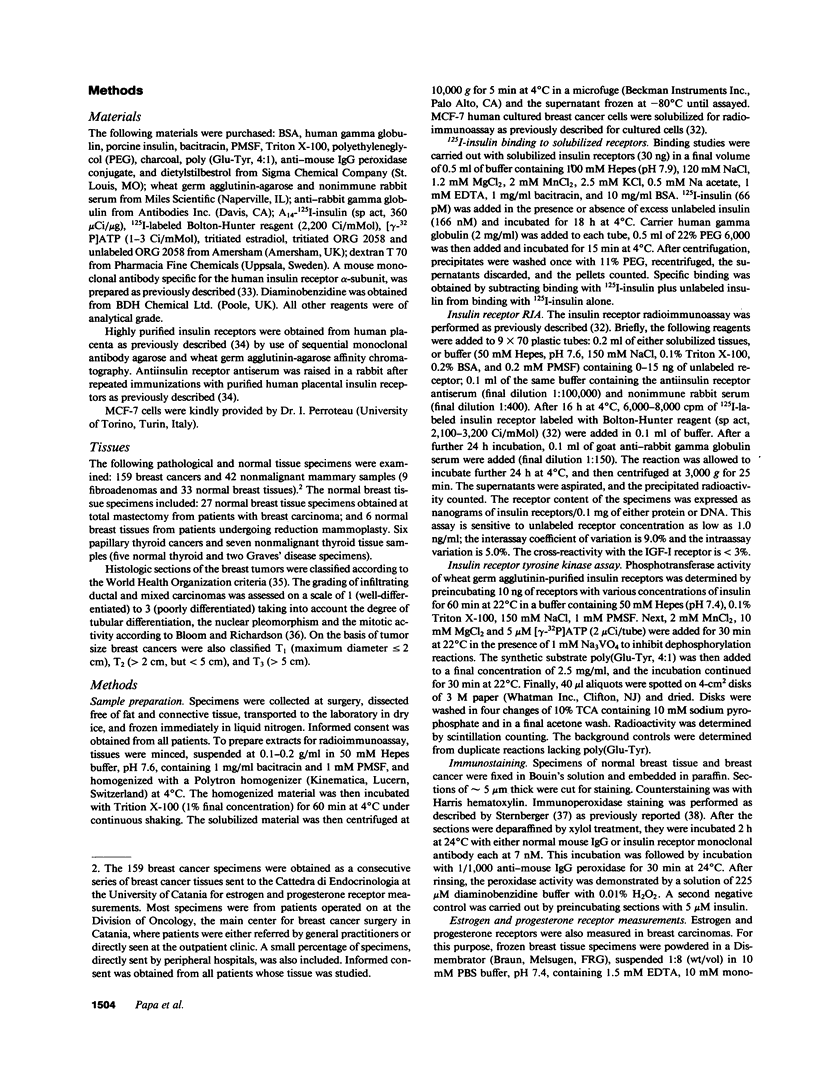
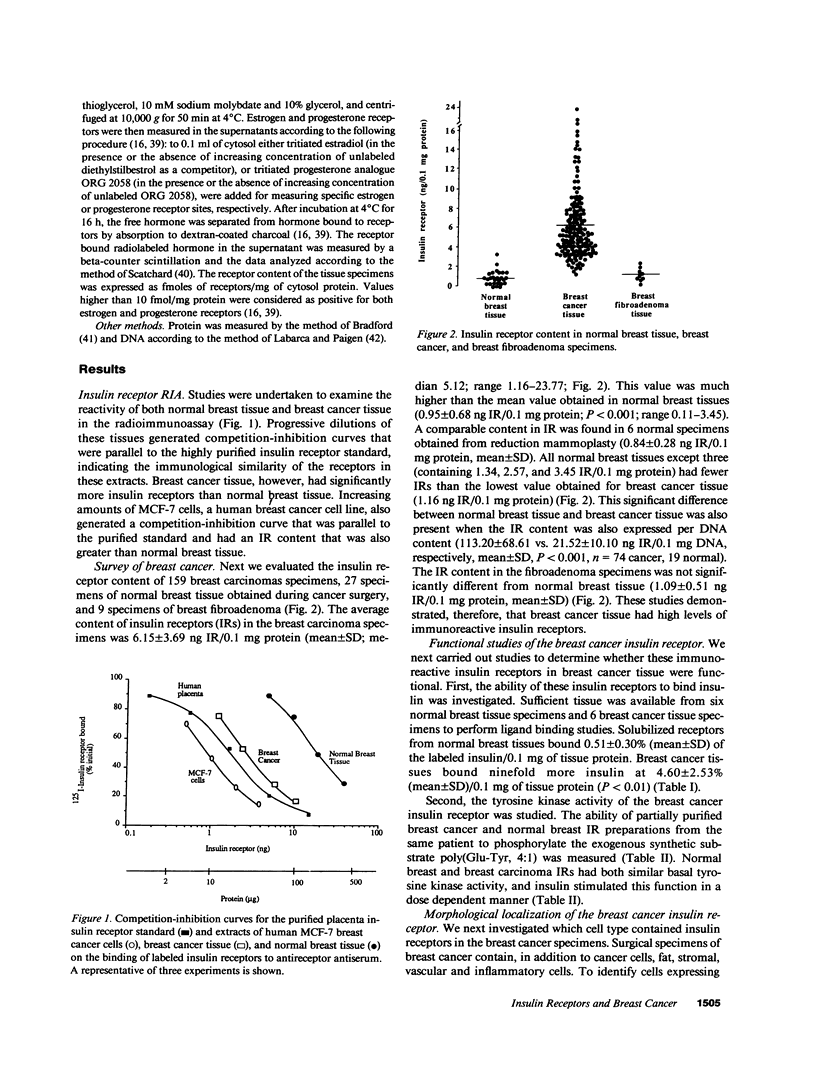
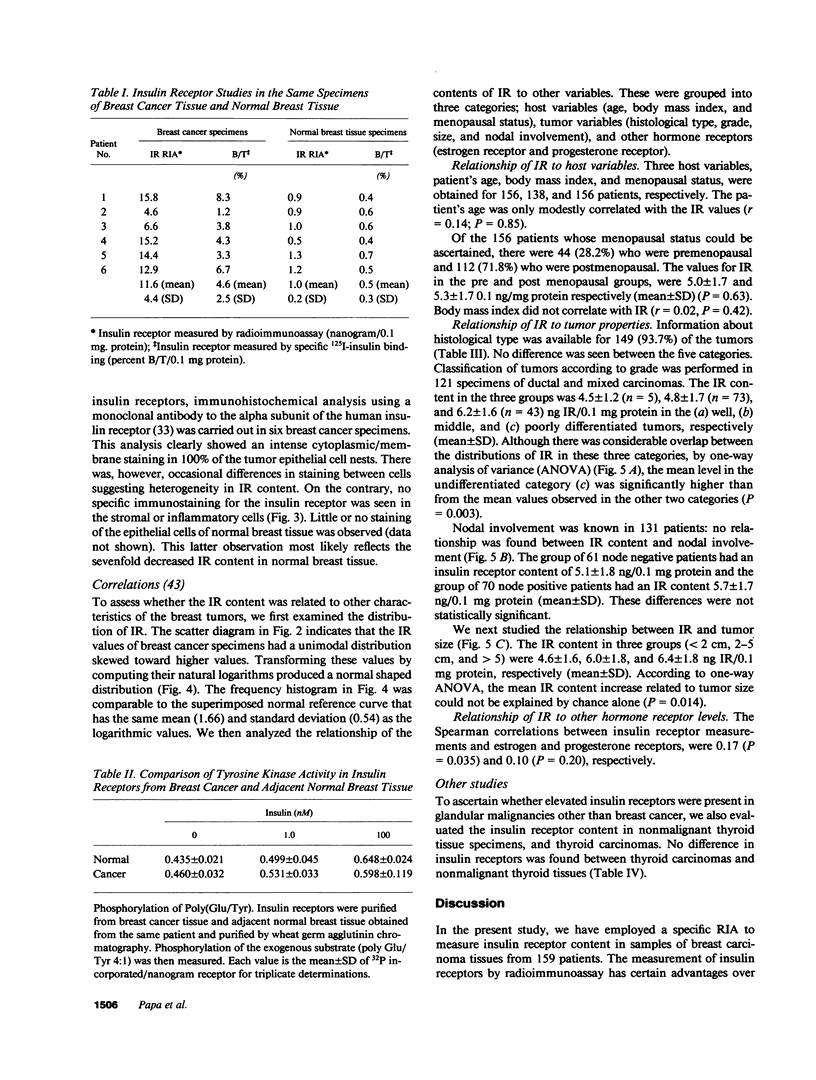
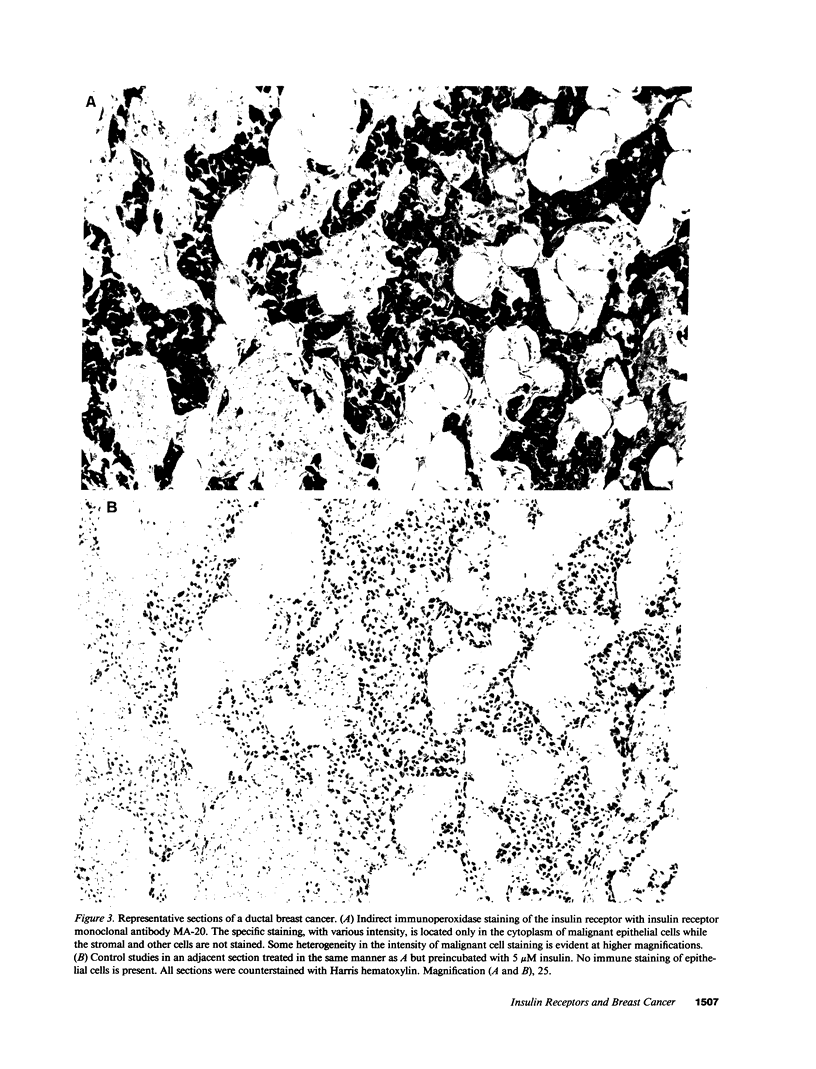
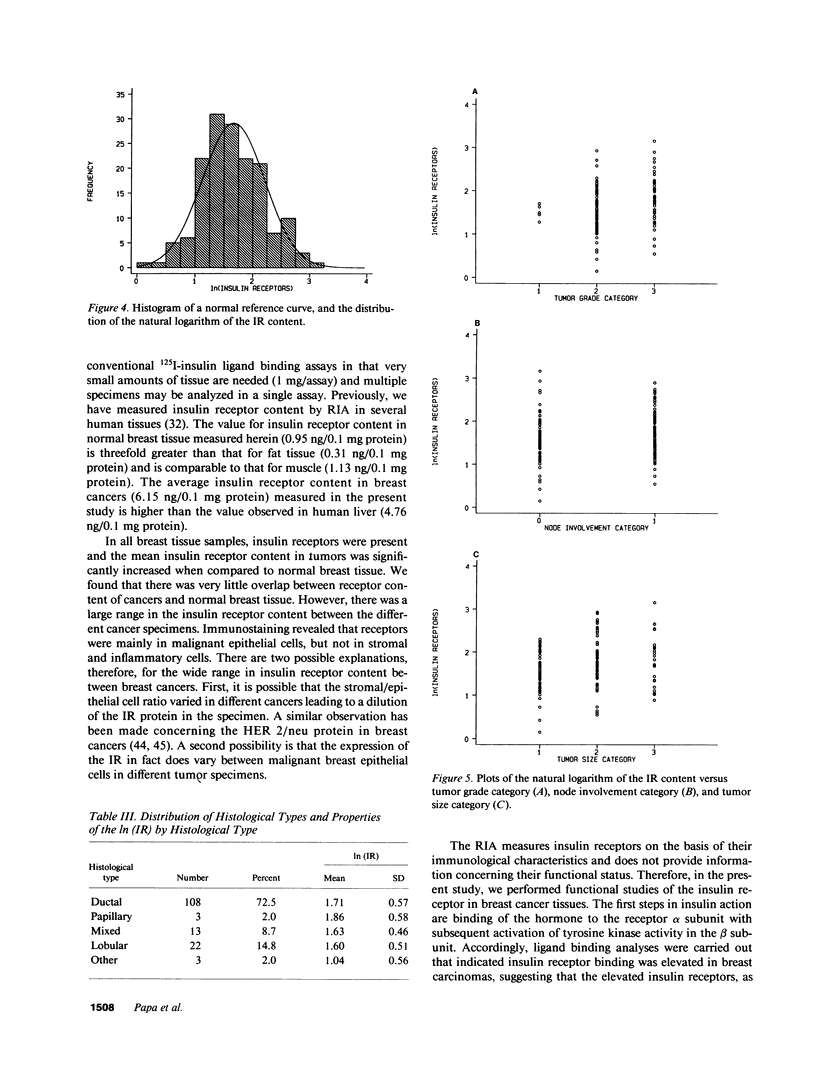

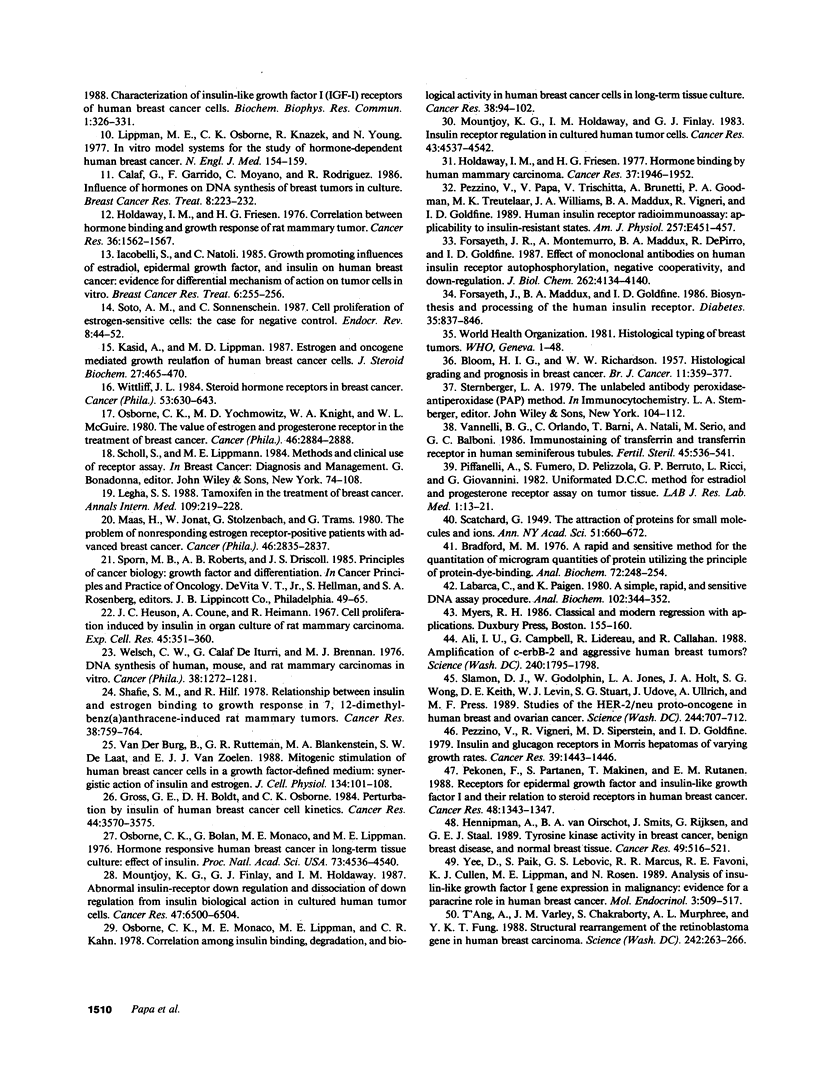
Images in this article
Selected References
These references are in PubMed. This may not be the complete list of references from this article.
- BLOOM H. J., RICHARDSON W. W. Histological grading and prognosis in breast cancer; a study of 1409 cases of which 359 have been followed for 15 years. Br J Cancer. 1957 Sep;11(3):359–377. doi: 10.1038/bjc.1957.43. [DOI] [PMC free article] [PubMed] [Google Scholar]
- Benson E. A., Holdaway I. M. Regulation of insulin binding to human mammary carcinoma. Cancer Res. 1982 Mar;42(3):1137–1141. [PubMed] [Google Scholar]
- Bradford M. M. A rapid and sensitive method for the quantitation of microgram quantities of protein utilizing the principle of protein-dye binding. Anal Biochem. 1976 May 7;72:248–254. doi: 10.1016/0003-2697(76)90527-3. [DOI] [PubMed] [Google Scholar]
- Burke R. E., McGuire W. L. Nuclear thyroid hormone receptors in a human breast cancer cell line. Cancer Res. 1978 Nov;38(11 Pt 1):3769–3773. [PubMed] [Google Scholar]
- Calaf G., Garrido F., Moyano C., Rodríguez R. Influence of hormones on DNA synthesis of breast tumors in culture. Breast Cancer Res Treat. 1986;8(3):223–232. doi: 10.1007/BF01807335. [DOI] [PubMed] [Google Scholar]
- Dickson R. B., Lippman M. E. Estrogenic regulation of growth and polypeptide growth factor secretion in human breast carcinoma. Endocr Rev. 1987 Feb;8(1):29–43. doi: 10.1210/edrv-8-1-29. [DOI] [PubMed] [Google Scholar]
- Engel L. W., Young N. A. Human breast carcinoma cells in continuous culture: a review. Cancer Res. 1978 Nov;38(11 Pt 2):4327–4339. [PubMed] [Google Scholar]
- Forsayeth J. R., Montemurro A., Maddux B. A., DePirro R., Goldfine I. D. Effect of monoclonal antibodies on human insulin receptor autophosphorylation, negative cooperativity, and down-regulation. J Biol Chem. 1987 Mar 25;262(9):4134–4140. [PubMed] [Google Scholar]
- Forsayeth J., Maddux B., Goldfine I. D. Biosynthesis and processing of the human insulin receptor. Diabetes. 1986 Jul;35(7):837–846. doi: 10.2337/diab.35.7.837. [DOI] [PubMed] [Google Scholar]
- Furlanetto R. W., DiCarlo J. N. Somatomedin-C receptors and growth effects in human breast cells maintained in long-term tissue culture. Cancer Res. 1984 May;44(5):2122–2128. [PubMed] [Google Scholar]
- Gross G. E., Boldt D. H., Osborne C. K. Perturbation by insulin of human breast cancer cell cycle kinetics. Cancer Res. 1984 Aug;44(8):3570–3575. [PubMed] [Google Scholar]
- Harmon J. T., Hilf R. Identification and characterization of the insulin receptor in the R3230AC mammary adenocarcinoma of the rat. Cancer Res. 1976 Nov;36(11 Pt 1):3993–4000. [PubMed] [Google Scholar]
- Hennipman A., van Oirschot B. A., Smits J., Rijksen G., Staal G. E. Tyrosine kinase activity in breast cancer, benign breast disease, and normal breast tissue. Cancer Res. 1989 Feb 1;49(3):516–521. [PubMed] [Google Scholar]
- Heuson J. C., Coune A., Heimann R. Cell proliferation induced by insulin in organ culture of rat mammary carcinoma. Exp Cell Res. 1967 Feb;45(2):351–360. doi: 10.1016/0014-4827(67)90185-1. [DOI] [PubMed] [Google Scholar]
- Holdaway I. M., Friesen H. G. Correlation between hormone binding and growth response of rat mammary tumor. Cancer Res. 1976 May;36(5):1562–1567. [PubMed] [Google Scholar]
- Holdaway I. M., Friesen H. G. Hormone binding by human mammary carcinoma. Cancer Res. 1977 Jul;37(7 Pt 1):1946–1952. [PubMed] [Google Scholar]
- Iacobelli S., Natoli C. Growth promoting influences of estradiol, epidermal growth factor, and insulin on human breast cancer: evidence for differential mechanism of action on tumor cells in vitro. Breast Cancer Res Treat. 1985;6(3):255–256. doi: 10.1007/BF01806777. [DOI] [PubMed] [Google Scholar]
- Kasid A., Lippman M. E. Estrogen and oncogene mediated growth regulation of human breast cancer cells. J Steroid Biochem. 1987;27(1-3):465–470. doi: 10.1016/0022-4731(87)90341-4. [DOI] [PubMed] [Google Scholar]
- Labarca C., Paigen K. A simple, rapid, and sensitive DNA assay procedure. Anal Biochem. 1980 Mar 1;102(2):344–352. doi: 10.1016/0003-2697(80)90165-7. [DOI] [PubMed] [Google Scholar]
- Legha S. S. Tamoxifen in the treatment of breast cancer. Ann Intern Med. 1988 Aug 1;109(3):219–228. doi: 10.7326/0003-4819-109-3-219. [DOI] [PubMed] [Google Scholar]
- Lippman M. E. Growth regulation of human breast cancer. Clin Res. 1985 Sep;33(3):375–382. [PubMed] [Google Scholar]
- Lippman M. E., Osborne C. K., Knazek R., Young N. In vitro model systems for the study of hormone-dependent human breast cancer. N Engl J Med. 1977 Jan 20;296(3):154–159. doi: 10.1056/NEJM197701202960307. [DOI] [PubMed] [Google Scholar]
- Maass H., Jonat W., Stolzenbach G., Trams G. The problem of nonresponding estrogen receptor-positive patients with advanced breast cancer. Cancer. 1980 Dec 15;46(12 Suppl):2835–2837. doi: 10.1002/1097-0142(19801215)46:12+<2835::aid-cncr2820461420>3.0.co;2-m. [DOI] [PubMed] [Google Scholar]
- Mountjoy K. G., Finlay G. J., Holdaway I. M. Abnormal insulin-receptor down regulation and dissociation of down regulation from insulin biological action in cultured human tumor cells. Cancer Res. 1987 Dec 15;47(24 Pt 1):6500–6504. [PubMed] [Google Scholar]
- Mountjoy K. G., Holdaway I. M., Finlay G. J. Insulin receptor regulation in cultured human tumor cells. Cancer Res. 1983 Oct;43(10):4537–4542. [PubMed] [Google Scholar]
- Osborne C. K., Bolan G., Monaco M. E., Lippman M. E. Hormone responsive human breast cancer in long-term tissue culture: effect of insulin. Proc Natl Acad Sci U S A. 1976 Dec;73(12):4536–4540. doi: 10.1073/pnas.73.12.4536. [DOI] [PMC free article] [PubMed] [Google Scholar]
- Osborne C. K., Monaco M. E., Lippman M. E., Kahn C. R. Correlation among insulin binding, degradation, and biological activity in human breast cancer cells in long-term tissue culture. Cancer Res. 1978 Jan;38(1):94–102. [PubMed] [Google Scholar]
- Osborne C. K., Yochmowitz M. G., Knight W. A., 3rd, McGuire W. L. The value of estrogen and progesterone receptors in the treatment of breast cancer. Cancer. 1980 Dec 15;46(12 Suppl):2884–2888. doi: 10.1002/1097-0142(19801215)46:12+<2884::aid-cncr2820461429>3.0.co;2-u. [DOI] [PubMed] [Google Scholar]
- Pekonen F., Partanen S., Mäkinen T., Rutanen E. M. Receptors for epidermal growth factor and insulin-like growth factor I and their relation to steroid receptors in human breast cancer. Cancer Res. 1988 Mar 1;48(5):1343–1347. [PubMed] [Google Scholar]
- Pezzino V., Papa V., Trischitta V., Brunetti A., Goodman P. A., Treutelaar M. K., Williams J. A., Maddux B. A., Vigneri R., Goldfine I. D. Human insulin receptor radioimmunoassay: applicability to insulin-resistant states. Am J Physiol. 1989 Sep;257(3 Pt 1):E451–E457. doi: 10.1152/ajpendo.1989.257.3.E451. [DOI] [PubMed] [Google Scholar]
- Pezzino V., Vigneri R., Siperstein M. D., Goldfine I. D. Insulin and glucagon receptors in Morris hepatomas of varying growth rates. Cancer Res. 1979 May;39(5):1443–1446. [PubMed] [Google Scholar]
- Pollak M. N., Polychronakos C., Yousefi S., Richard M. Characterization of insulin-like growth factor I (IGF-I) receptors of human breast cancer cells. Biochem Biophys Res Commun. 1988 Jul 15;154(1):326–331. doi: 10.1016/0006-291x(88)90688-2. [DOI] [PubMed] [Google Scholar]
- Shafie S. M., Hilf R. Relationship between insulin and estrogen binding to growth response in 7,12-dimethylbenz(a)anthracene-induced rat mammary tumors. Cancer Res. 1978 Mar;38(3):759–764. [PubMed] [Google Scholar]
- Shiu R. P. Prolactin receptors in human breast cancer cells in long-term tissue culture. Cancer Res. 1979 Nov;39(11):4381–4386. [PubMed] [Google Scholar]
- Slamon D. J., Godolphin W., Jones L. A., Holt J. A., Wong S. G., Keith D. E., Levin W. J., Stuart S. G., Udove J., Ullrich A. Studies of the HER-2/neu proto-oncogene in human breast and ovarian cancer. Science. 1989 May 12;244(4905):707–712. doi: 10.1126/science.2470152. [DOI] [PubMed] [Google Scholar]
- Soto A. M., Sonnenschein C. Cell proliferation of estrogen-sensitive cells: the case for negative control. Endocr Rev. 1987 Feb;8(1):44–52. doi: 10.1210/edrv-8-1-44. [DOI] [PubMed] [Google Scholar]
- T'Ang A., Varley J. M., Chakraborty S., Murphree A. L., Fung Y. K. Structural rearrangement of the retinoblastoma gene in human breast carcinoma. Science. 1988 Oct 14;242(4876):263–266. doi: 10.1126/science.3175651. [DOI] [PubMed] [Google Scholar]
- Vannelli B. G., Orlando C., Barni T., Natali A., Serio M., Balboni G. C. Immunostaining of transferrin and transferrin receptor in human seminiferous tubules. Fertil Steril. 1986 Apr;45(4):536–541. doi: 10.1016/s0015-0282(16)49284-8. [DOI] [PubMed] [Google Scholar]
- Welsch C. W., Iturri G. C., Brennan M. J. DNA synthesis of human, mouse, and rat mammary carcinomas in vitro: influence of insulin and prolactin. Cancer. 1976 Sep;38(3):1272–1281. doi: 10.1002/1097-0142(197609)38:3<1272::aid-cncr2820380330>3.0.co;2-r. [DOI] [PubMed] [Google Scholar]
- Wittliff J. L. Steroid-hormone receptors in breast cancer. Cancer. 1984 Feb 1;53(3 Suppl):630–643. doi: 10.1002/1097-0142(19840201)53:3+<630::aid-cncr2820531308>3.0.co;2-3. [DOI] [PubMed] [Google Scholar]
- Yee D., Paik S., Lebovic G. S., Marcus R. R., Favoni R. E., Cullen K. J., Lippman M. E., Rosen N. Analysis of insulin-like growth factor I gene expression in malignancy: evidence for a paracrine role in human breast cancer. Mol Endocrinol. 1989 Mar;3(3):509–517. doi: 10.1210/mend-3-3-509. [DOI] [PubMed] [Google Scholar]
- van der Burg B., Rutteman G. R., Blankenstein M. A., de Laat S. W., van Zoelen E. J. Mitogenic stimulation of human breast cancer cells in a growth factor-defined medium: synergistic action of insulin and estrogen. J Cell Physiol. 1988 Jan;134(1):101–108. doi: 10.1002/jcp.1041340112. [DOI] [PubMed] [Google Scholar]




